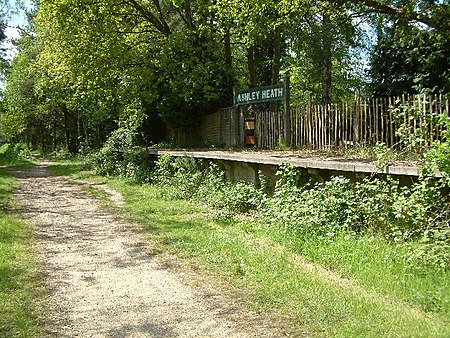Ashley Heath Halt railway station
Beeching closures in EnglandDisused railway stations in DorsetFormer Southern Railway (UK) stationsPages with no open date in Infobox stationRailway stations in Great Britain closed in 1964 ... and 3 more
Railway stations in Great Britain opened in 1927South West England railway station stubsUse British English from January 2018

Ashley Heath Halt was a railway station on the Southampton and Dorchester Railway formerly in the county of Hampshire (now part of Dorset). Opened in 1927, it served the areas of St Leonards and St Ives as well as the village of Ashley Heath itself. This was an emerging residential area, the northern part of what is now the South East Dorset conurbation. The halt consisted of two concrete platforms each with a shelter. There was also a public siding for goods traffic behind the down (south) side platform. The halt was closed during the Beeching Axe, losing its passenger trains in 1964.
Excerpt from the Wikipedia article Ashley Heath Halt railway station (License: CC BY-SA 3.0, Authors, Images).Ashley Heath Halt railway station
Horton Road,
Geographical coordinates (GPS) Address Nearby Places Show on map
Geographical coordinates (GPS)
| Latitude | Longitude |
|---|---|
| N 50.8417 ° | E -1.8409 ° |
Address
Horton Road
Horton Road
BH24 2EJ , St. Leonards and St. Ives
England, United Kingdom
Open on Google Maps











